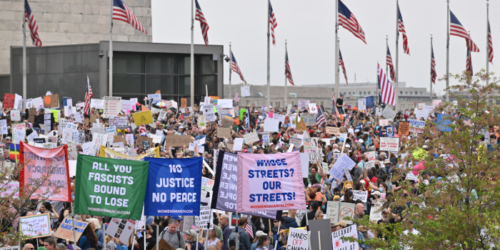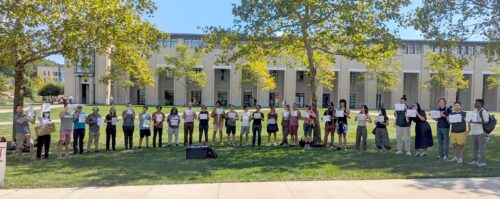For the past three legislative cycles, state lawmakers have tabled record numbers of bills that harmfully target LGBTQ+ people or seek to enforce chauvinistic ideas about sexuality and gender norms. Crowd Counting Consortium (CCC) data show how that torrent of legislative hate and harm has helped to spur a counter-mobilization that includes — but isn’t limited to — a substantial and ongoing wave of protests and other demonstrations against those bills.
The column chart below shows monthly counts of pro-LGBTQ+ demonstrations in the U.S. from January 1, 2021, through March 14, 2023. In the columns, the red parts indicate what share of each month’s events included any demands or claims by participants about legislation.
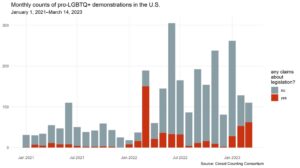
As the chart shows, pro-LGBTQ+ demonstrations surged in March 2022, when students across Florida staged scores of walkouts in response to the passage of that state’s so-called Don’t Say Gay bill, which sharply limits classroom instruction on sexual orientation and gender identity. The rate of pro-LGBTQ+ demonstrations nationwide has remained high ever since, however, averaging more than 160 per month over the following year. In just the first two weeks of March 2023 — a busy month in many state legislative calendars — CCC has already logged more than 100 pro-LGBTQ+ demonstrations, and more than half of them have explicitly referenced state legislation.
Notably, a sizeable share of these demonstrations are occurring in states that don’t typically factor in national conversations about the LGBTQ+ community or left-wing activism, because that’s where many of these bills are advancing or even passing into law. The chart below shows counts of pro-LGBTQ+ demonstrations referencing legislation (the red parts of the columns in the previous chart) by state over that same period. Florida — the third-largest state by population and, according to Governor DeSantis, “where woke goes to die” — leads by far with nearly 150 events, and first– and second-largest states California and Texas also rank in the top five. More telling, though, is the appearance near the top of that list of much smaller “red” states like Iowa, South Dakota, Kentucky, Arkansas, Utah, Montana, and Oklahoma, to name a few.
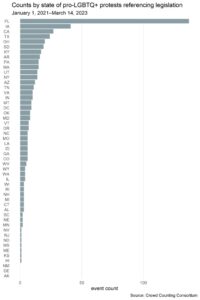
Iowa’s extraordinary position as second on that list is due in no small part to a coordinated set of student walkouts on Wednesday, March 1, 2023, that was led by Iowa WTF and the Iowa Queer Student Alliance and drew more than 1,000 students from at least 27 schools across 21 cities and towns, according to CCC data. This fight has continued to draw large crowds in opposition there, with an estimated 2,000 people gathering on the steps of the capitol in Des Moines for the Rally to Resist on Sunday, March 5, and hundreds turning out in both Davenport and Cedar Rapids this past Saturday, March 11.
These unusually large event counts and crowd sizes in smaller, more conservative states demonstrate how local LGBTQ+ organizations and communities and their allies are mobilizing and fighting back against this unprecedented wave of legislative threats to their rights, dignity, health, and even survival.
Importantly, malicious legislation is not the only threat driving this uprising. As we’ve discussed on this blog before, over the past year, the queer community has also faced a historic wave of anti-LGBTQ+ activism in the streets, with a peculiar and apparently intensifying fixation on Drag Story Hour events and other drag performances.
As shown in the chart below, this wave of reactionary protests surged around Pride Month in 2022 and again in the fall. Although it peaked in October in the run-up to Election Day, it has persisted through the winter — typically a seasonal downtime for all forms of protest — and into 2023. As we discussed in our overview of right-wing protest in 2022, while the crowds at these protests sometimes include groups engaged in quiet prayer and other less threatening activities, they have also drawn a smorgasbord of violent and openly fascist actors who look to terrorize performers and attendees, bully community-defense organizations, and draw media attention that can help them normalize their extremism and recruit new members.
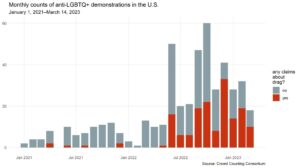
Neither those threats nor the mobilization against them show any sign of abating soon, and calls from organizers lead us to expect scores if not hundreds more demonstrations in defense of the LGBTQ+ community nationwide over the next few weeks.
- On Friday, March 17, organizers in several cities, including Boston, Chicago, Denver, Madison, and Spokane, are coordinating rallies against anti-trans legislation and hate on what they’re calling Trans Day of Resistance.
- March 31 is International Transgender Day of Visibility. In addition to regular celebrations of that day across the country, a student-led group in Florida, Project Caerus, has called for school walkouts to protest anti-LGBTQ+ laws and rhetoric in their state.
- That same day, Queer Youth Assemble — which organized a wave of student walkouts spanning more than a dozen states in March 2022 — has called for demonstrations in all 50 state capitals and Washington, DC, as part of what they’re calling the March for Queer & Trans Youth Autonomy.
- On March 31 and April 1, Trans Radical Activist Network is teaming with Our Rights DC to lead a weekend of marches and protests under the title Trans Day of Vengeance with “stop trans genocide” as its slogan.
We’ll be tracking those (and thousands of other) events as they are announced and occur in our monthly Google Sheets, which are publicly visible, and in the compiled and augmented version of our full dataset on our GitHub repository. If you’re an activist, journalist, or researcher interested in using the data or statistics or visualizations derived from them, please drop me a line at julfelder@hks.harvard.edu. All of this data is freely available to the public without registration, but I’m happy to provide guidance or advice on how to use it as needed.
